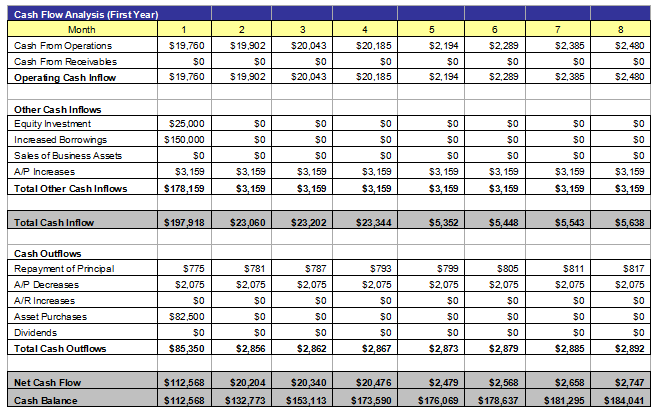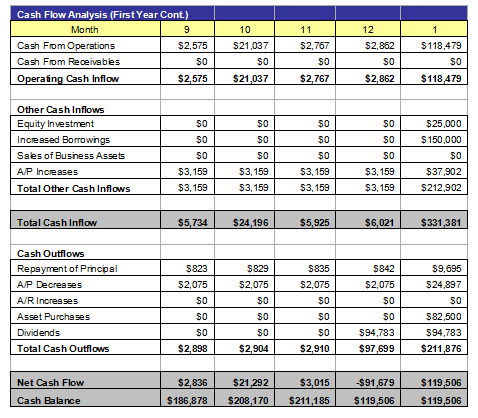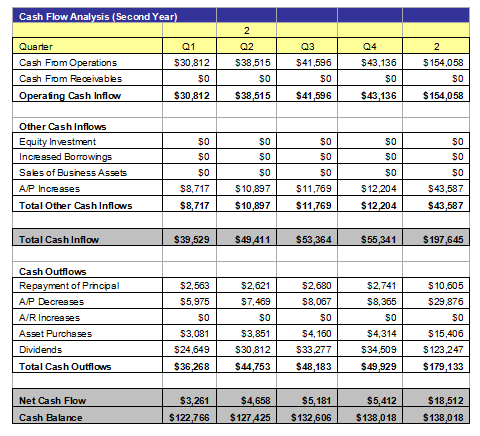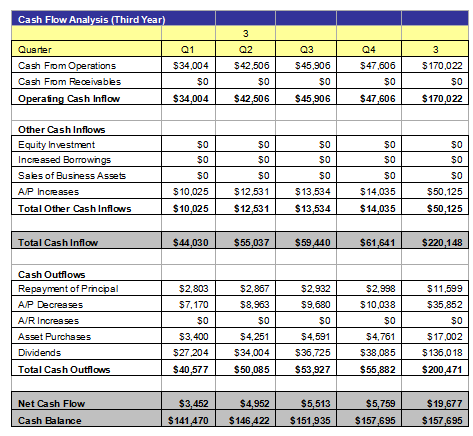Free Taxi Service Business Plan
For Raising Capital from Investors, Banks, or Grant Companies!
Please note that the financials
in this complete free business plan are completely fictitious and may not
match the text of the business plan below. This free business plan demonstration
purposes only. If you are interested in purchasing the completed editable MS Word
and Excel documents for this business plan, please click the button below! Also,
the text of the business plan is formatted with a fully automated
table of contents.
Return to
Samples Page
It should be noted that there is no special software required to use these
templates. All business plans come in Microsoft Word and Microsoft Excel format.
Each business plan features:
- Excecutive Summary
- Company and Financing Summary
- Products and Services Overview
- Strategic Analysis with current research!
- Marketing Plan
- Personnel Plan
- 3 Year Advanced Financial Plan
- Expanded Financial Plan with Monthly Financials
- Loan Amortization and ROI Tools
- FREE PowerPoint Presentation for Banks, Investors,
or Grant Companies!
1.0 Executive Summary
The purpose of this business plan is to raise $200,000 for the development of a taxi cab service while showcasing the expected financials and operations over the next three years. Taxi Cab Service, Inc. (“the Company”) is a New York based corporation that will provide taxi and chauffeuring services to customers in its targeted market. The Company was founded in 2009 by John Doe.
1.1 Products and Services
The Taxi Cab Service will specialize in providing customers with chauffeuring/taxi services within 50 miles of its office location. The Company will charge its customers on a per mile basis, or for longer trips on a flat fee basis. Additionally, the Taxi Cab Service will directly employ its staff of drivers, and the business will be able to accommodate any pick up or delivery of a person to and from their destination at anytime. Taxi Cab Service will comply with all local, state, and federal laws regarding the rendering of taxiing services. The third section of the business plan will further describe the services offered by the Taxi Cab Service.
1.2 The Financing
Mr. Doe is seeking to raise $200,000 from as a bank loan. The interest rate and loan agreement are to be further discussed during negotiation. This business plan assumes that the business will receive a 10 year loan with a 9% fixed interest rate.
1.3 Mission Statement
The Taxi Cab Service’s mission is to provide clean and affordable chauffer travel for short distance trips within the target market.
1.4 Mangement Team
The Company was founded by John Doe. Mr. Doe has more than 10 years of experience in the transportation management industry. Through his expertise, he will be able to bring the operations of the business to profitability within its first year of operations.
1.5 Sales Forecasts
Mr. Doe expects a strong rate of growth at the start of operations. Below are the expected financials over the next three years.
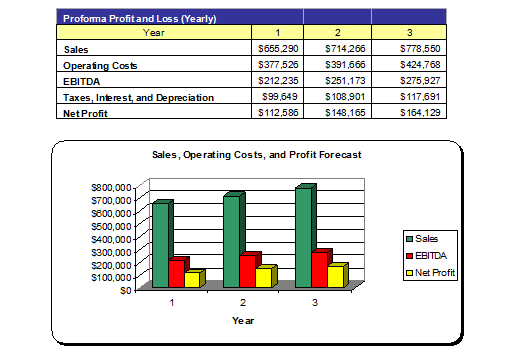
1.6 Expansion Plan
The Founder expects that the business will aggressively expand during the first three years of operation. Mr. Doe intends to implement marketing campaigns that will effectively target individuals and companies with ongoing transportation needs within the target market.
2.0 Company and Financing Summary
2.1 Registered Name and Corporate Structure
Taxi Cab Service, Inc. The Company is registered as a corporation in the State of New York.
2.2 Required Funds
At this time, the Taxi Cab Service requires $200,000 of debt funds. Below is a breakdown of how these funds will be used:
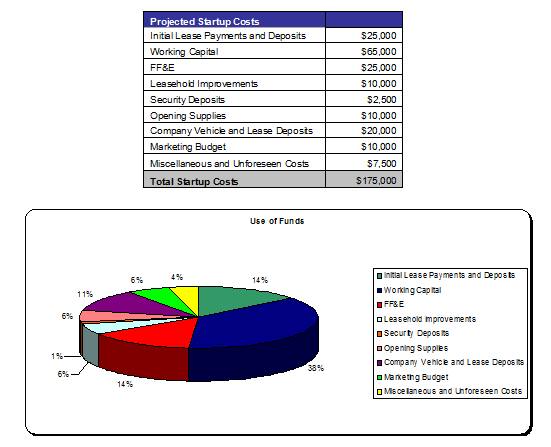
2.3 Investor Equity
Mr. Doe is not seeking an investment from a third party at this time.
2.4 Management Equity
John Doe owns 100% of the Taxi Cab Service, Inc.
2.5 Exit Strategy
If the business is very successful, Mr. Doe may seek to sell the business to a third party for a significant earnings multiple. Most likely, the Company will hire a qualified business broker to sell the business on behalf of the Taxi Cab Service, Inc\. Based on historical numbers, the business could fetch a sales premium of up to 4 times earnings.
3.0 Products and Services
The Company’s taxi vehicles (which will either be a converted large four door sedan or a town car) will operate in constant operation, and are expected to generate up to $260 per day of vehicle fees (per vehicle). Taxi Cab Service, Inc. will provide services to both individuals and companies that have ongoing local transportation needs. On busy evenings, the Taxi Cab Service will travel among heavy populated and frequented areas to drive individuals that are exiting clubs, restaurants, and other nighttime venues. At least one of the Company’s vehicles will operate in this capacity during the evening time hours. On the weekends, two of the Company’s vehicles will operate in this capacity. As time progresses, the Company will continually add more taxi drivers and vehicles to its fleet to further increase sales. In the future, the business may seek to use lease financing for vehicles, which would allow the Company to operate with a more stable balance sheet while concurrently earning a higher return on its investment. At all times, the business will ensure that each of its retained drivers is properly licensed to operate a taxi cab and that the Company also maintains all proper insurance and licensure for the operation of this business.
4.0 Strategic and Market Analysis
4.1 Economic Outlook
This section of the analysis will detail the economic climate, the taxi industry, the customer profile, and the competition that the business will face as it progresses through its business operations. Currently, the economic market condition in the United States is moderate. The meltdown of the sub prime mortgage market coupled with increasing gas prices has led many people to believe that the US is on the cusp of an economic recession. This slowdown in the economy has also greatly impacted real estate sales, which has halted to historical lows. However, taxi services are typically immune from changes in the general economy as people that require short distance travel will continue to use these services. Additionally, the high margin income generated from taxiing services will ensure that the business can remain profitable and cash flow positive despite the current economic environment.
4.2 Industry Analysis
Taxi operations provide over $5 billion dollars a year to the general US economy. The industry employs more than 47,000 people, and provides annual payrolls that exceed $900 million dollars per year. The growth rate of this industry has remained in step with that the general growth of the country’s GDP. Management feels that by maintaining a local client base, the Company can continue to generate revenues despite the current deleterious economic conditions in the United States. The average taxi or limousine company has 9 employees and grosses $600,000 per year in revenue. While the taxi cab business’ revenue is predominately driven by business and travel; small companies can indeed very productively compete with their larger counter-parts. This ability, of course, is dependent upon their marketing strategies and the effectiveness of that marketing.
4.3 Customer Profile
In this section of the analysis, you should describe the type of customer you are seeking to acquire. These traits include income size, type of business/occupation; how far away from your business is to your customer, and what the customer is looking for. In this section, you can also put demographic information about your target market including population size, income demographics, level of education, etc.
4.4 Competitive Analysis
This is one of the sections of the business plan that you must write completely on your own. The key to writing a strong competitive analysis is that you do your research on the local competition. Find out who your competitors are by searching online directories and searching in your local Yellow Pages. If there are a number of competitors in the same industry (meaning that it is not feasible to describe each one) then showcase the number of businesses that compete with you, and why your business will provide customers with service/products that are of better quality or less expensive than your competition.
5.0 Marketing Plan
The Taxi Cab Service intends to maintain an extensive marketing campaign that will ensure maximum visibility for the business in its targeted market. Below is an overview of the marketing strategies and objectives of the Company
5.1 Marketing Objectives
-
• Establish relationships with local companies with ongoing transportation needs within the targeted market.
-
• Implement a local campaign with the Company’s targeted market via the use of flyers, local newspaper advertisements, and word of mouth advertising.
-
• Develop an online presence by developing a website and placing the Company’s name and contact information with online directories.
5.2 Marketing Strategies
Mr. Doe intends on using a number of marketing strategies that will allow the Taxi Cab Services to easily target individuals and businesses within the target market. These strategies include traditional print advertisements and ads placed on search engines on the Internet. Below is a description of how the business intends to market its services to the general public. Taxi Cab Service will also use an internet based strategy. This is very important as many people seeking local services, such as taxis, now the Internet to conduct their preliminary searches. Mr. Doe will register the Taxi Cab Service with online portals so that potential customers can easily reach the business. The Company will also develop its own online website regarding pricing, and how to contact the Company for taxiing services. Additionally, Mr. Doe will seek to develop ongoing relationships (which may include the usage of house accounts) among local businesses (or large businesses that operate locally) that require regular transportation needs for their personnel or clients. In time, this will become an invaluable source of revenue for the business.
5.3 Pricing
In this section, describe the pricing of your services and products. You should provide as much information as possible about your pricing as possible in this section. However, if you have hundreds of items, condense your product list categorically. This section of the business plan should not span more than 1 page.
6.0 Organizational Plan and Personnel Summary
6.1 Corporate Organization
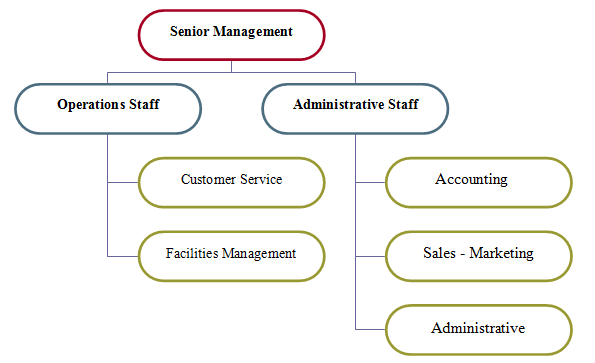
6.2 Organizational Budget
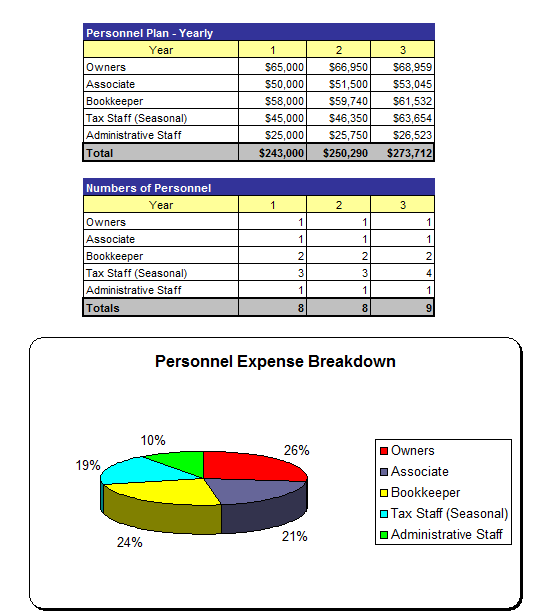
6.3 Management Biographies
In this section of the business plan, you should write a two to four paragraph biography
about your work experience, your education, and your skill set. For each owner or
key employee, you should provide a brief biography in this section.
7.0 Financial Plan
7.1 Underlying Assumptions
-
• Taxi Cab Service, Inc. will have an annual revenue growth rate of 8% per year.
-
• The Owner will acquire $200,000 of debt funds to develop the business.
-
• The loan will have a 10 year term with a 9% interest rate.
7.2 Sensitivity Analysis
In the event of an economic downturn, the business may have a decline in its revenues. However, and as stated earlier, people will continue to use cab services despite deleterious changes to the economy. This is especially true among people that frequent nighttime venues and require a ride home upon exiting. As such, this and the high margins earned from services will ensure that the Taxi Cab Service can continually pay its month to month financial obligations.
7.3 Source of Funds
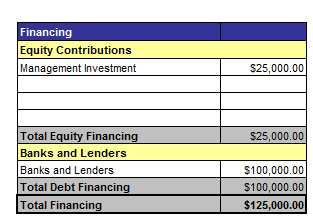
7.4 General Assumptions
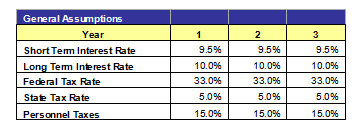
7.5 Profit and Loss Statements
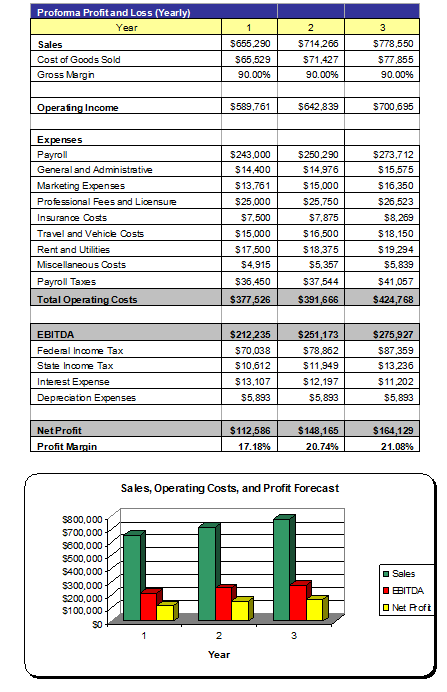
7.6 Cash Flow Analysis
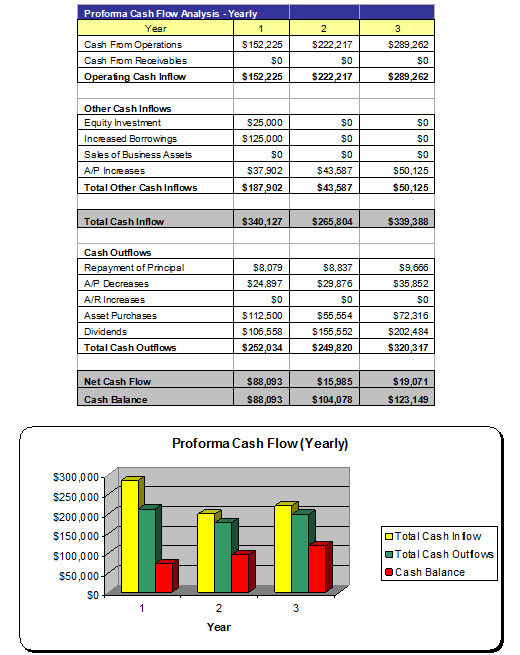
7.7 Balance Sheet
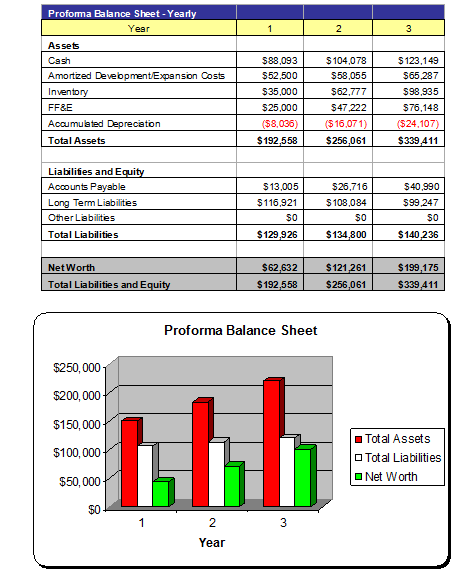 .
.
7.8 General Assumptions
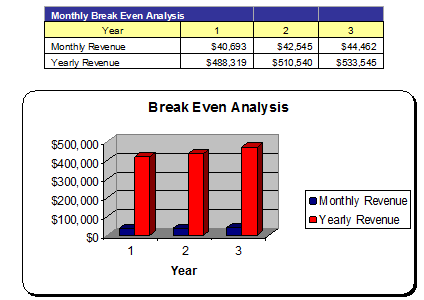
7.9 Business Ratios

Expanded Profit and Loss Statements
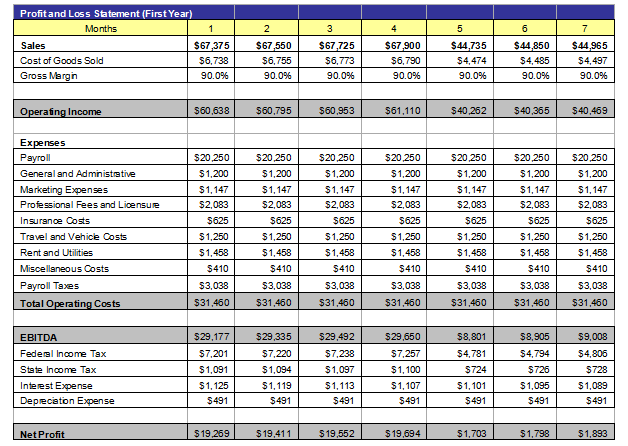
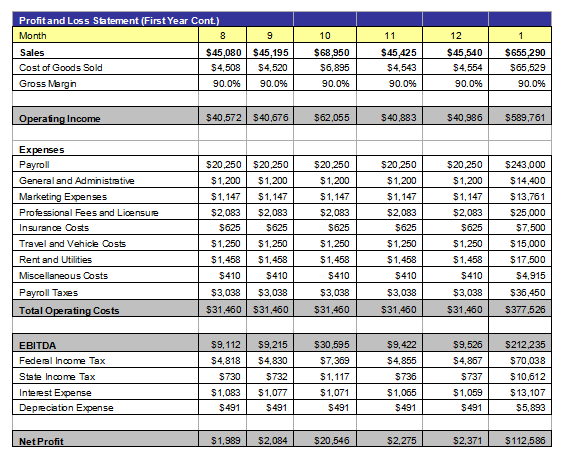
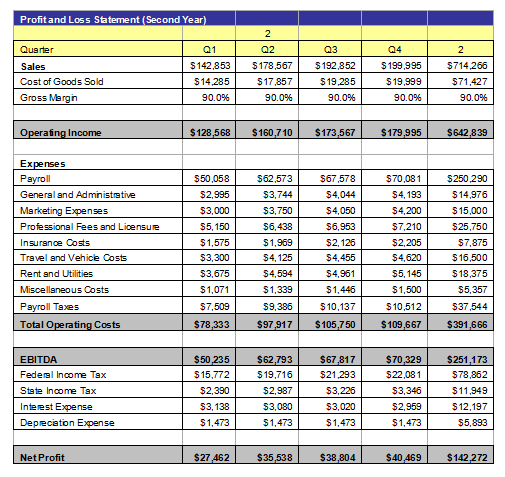
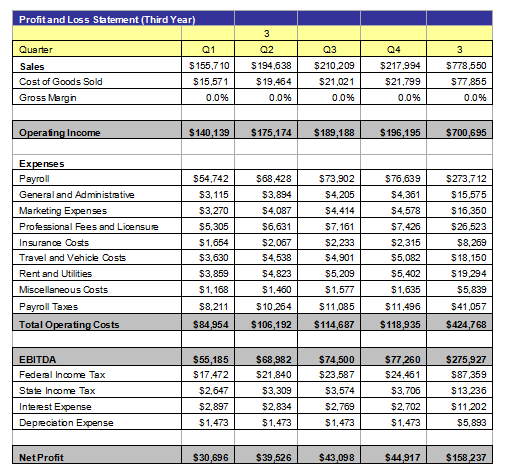
Expanded Cash Flow Analysis
